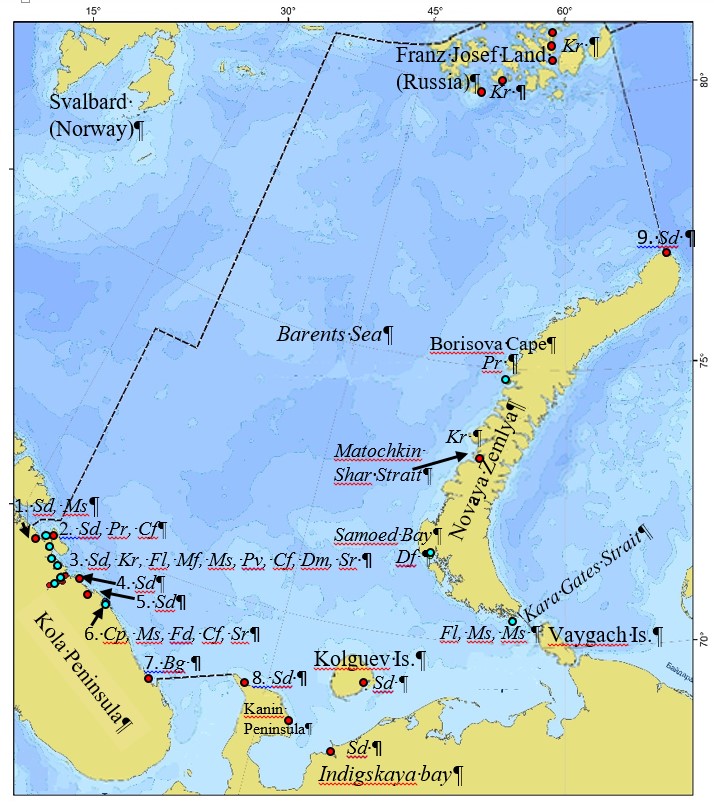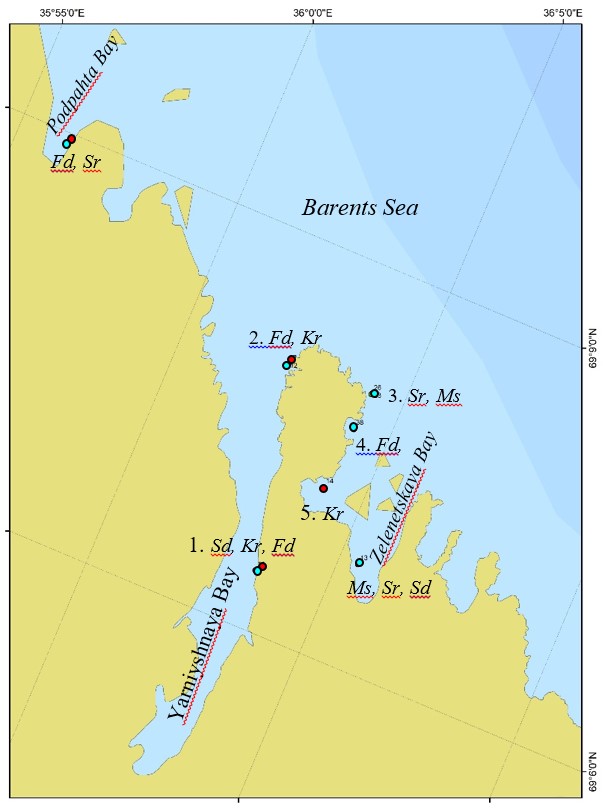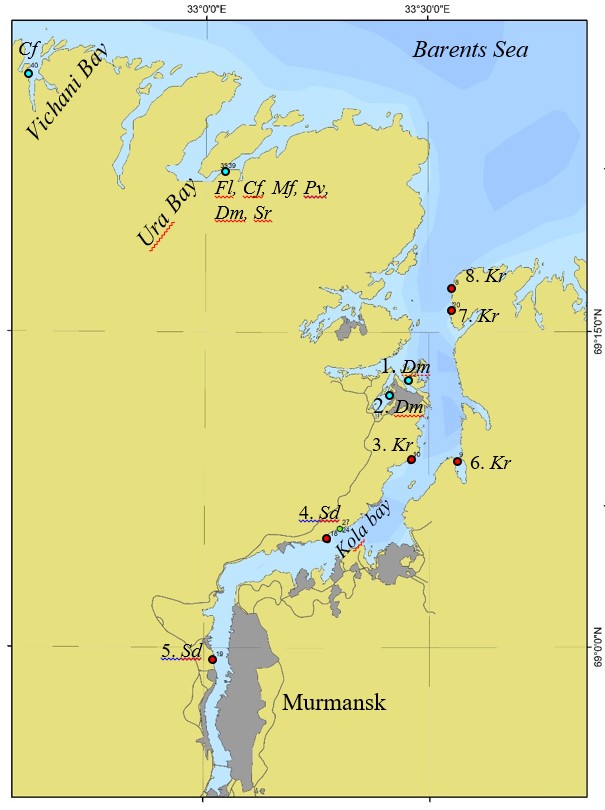Abstract
At present, in connection with the increasing anthropogenic load, global climate change and a decrease in the species diversity of algae, the issues of the protection of marine macrophytes, including species of the Barents Sea, are just beginning to be developed. Spatial accounting of protected species is especially important for the establishment of priority protected areas. Therefore, the purpose of this work was to collect information and present it in the form of maps of distribution of rare and endangered species in the Barents Sea. The work presents schematic maps that include information on the distribution of rare (Phaeophyceae: Feldmannia kjellmanii, Myrionema strangulans, Myrionema foecundum, Pseudoralfsia verrucose, Fucus distichus subsp.evanescens; Chlorophyta: Codium firma, Peyssonnelia rosenvingei, Choreocolax polysiphoniae) and protected (Batrachospermum gelatinosum, Kornmannia leptoderma, Saccorhiza dermatodea) species of the Barents Sea. Considering that the above-described species often have a narrow range and low frequency of occurrence, it was proposed to grant them a protected status and take into account their presence when planning any economic activity in the Barents Sea.
Keywords: Barents Sea, macrophytes, protected algae, rare algae
Introduction
In connection with the increasing anthropogenic load, global climate change and a decrease in the species diversity of algae, the issues of the protection of algae are just beginning to be developed. The protection of certain types of macrophytes, especially microscopic ones, seems to be ineffective, therefore some scientists propose to identify protected areas - "algoreserves", where rare species would have the greatest abundance and diversity (Komulainen, 2009). To identify such territories, it is necessary to have complete data on the distribution and abundance of species of various groups of algae, including rare and already protected ones. The spatial distribution of macrophyte algae within the Barents Sea has not yet been fully studied due to the inaccessibility of the northern territories due to the ice regime, terrain features and lack of funding.
The species composition of macrophyte algae in the mainland part of the Barents Sea has been studied in sufficient detail. The most detailed data are given in the works of Zinova (1953, 1955), Vinogradova (1974), Blinova (2007), Malavenda with colleagues (2014, 2017, 2018) and Evseeva (2018). Many researchers note that some species are so rare here that they acquire a conservation status (Malavenda et al., 2017). The creation of maps of the occurrence of protective and rare species of algae is necessary for the development of feasibility studies for the design of potentially hazardous industries, for example, the construction of oil platforms, oil refineries and oil pipelines, or to determine an emergency response plan.
Purpose of the Study
Therefore, the purpose of this work was to collect information and present it in the form of maps of occurrence of rare and protected species in the Barents Sea.
Research Methods
The material for this work was information from the Red Book of the Murmansk Region (KKMO), works by Zinova (1953, 1955), Vinogradova (1974), Blinova (2007), Malavenda with colleagues (2014, 2017, 2018) and Evseeva. (2018); the international database on taxonomy and distribution of algae Algaebase (Guiry & Guiry, 2021). A complete list of the distribution of species in the Barents Sea was compiled, from which species included in the Red Book of the Murmansk region (2021), with a narrow range, rarely found in the Barents Sea, were selected, and maps of the distribution of new, rare and protected species were created in the ArcGIS program.
Findings
Today, the Red Book of the Murmansk Region (KKMO) (2021) has 3 types of macrophyte algae. According to various researchers, these species are quite common on the coast of the Barents Sea: they are recorded in the southwest and southeast of the Murmansk coast, off the shores of the Novaya Zemlya and Franz Josef Land archipelagoes (Figures 1,2,3).
Phylum Rhodophyta, Class Florideophyceae
Order Batrachospermales
Family Batrachospermaceae
has the status of an object of the 4th category - "undefined status", i.e. there are not enough data on its distribution within the Barents Sea. The species lives in fresh waters and is found in the estuary section of the river. Curve and p. Ponoy, southeast of the village. Krasnoschelye (Figures 1). Moreover, in Russia, this species is widespread and recorded in the European and Asian parts (Guiry & Guiry, 2021). Also grows in North America, Europe, Asia and Australia. It is more often found in single specimens in rapidly flowing waters: rivers, streams and springs, as well as in lakes and swamps. Interestingly, it is one of the few freshwater red algae species (RBMR, 2021).
Phylum Chlorophyta, Class Ulvophyceae
Order Ulvales
Family Kornmanniaceae
has the status of the 3rd category - "rare, in a state close to threatened." The species belongs to the highly boreal North Atlantic-Ice Tomsk and is characterized by a narrow ecological amplitude. The northern border of the range runs in the Barents Sea. Inhabits sheltered places (kuta of bays) in the middle and lower horizons of a gentle sandy-stony littoral zone. It is a typical epiphyte of sea grasses, red and brown macrophytic algae. The decrease in the number of this species is caused by the siltation of the innermost sections of the bays, caused by domestic and economic pollution. The number of the species has not been studied sufficiently. The species is widespread in the Barents Sea. K. leptoderma was found in the lower horizon of the rocky littoral zone of the Kola Bay (Malavenda, 2018), Yarnishnaya bays (Malavenda et al., 2017) and Zelenetskaya (Malavenda & Makarov, 2014). It was found off the coast of Franz Josef Land near the islands of Hooke, Etheridge, Kuna, Brosh, and the Komsomolsky Islands (Vinogradova & Shoshina, 1994). Near Novaya Zemlya, it was recorded in the Matochkin Shar Strait (Shtrik et al., 2000) (Figure 1). The species is also found in the White, Bering and Japan Seas, off the coast of Canada and Svalbard, off about. Greenland, North America and northern parts of Europe, as well as Central America and off the coast of Japan, Kamchatka and the Commander Islands (RBMR, 2021).
Phylum Ochrophyta, Class Phaeophyceae
Order Tilopteridales
Family Phyllariaceae
has the status of the 2nd category - “vulnerable, including declining in numbers, has a limited range on the territory of the Russian Federation”. The species is North Atlantic-Ice Tomsk, inhabits the sublittoral zone mainly at a depth of 3-6 m to 20 m, on rocky-stony soils in places with increased hydrodynamics (on capes, open coasts, in straits with strong currents). It is confined to associations formed by the genera Laminaria and Alaria. S. dermatodea grows in the sublittoral zone of the Novaya Zemlya archipelago in the area of the Russian Arctic National Park (Shoshina & Anisimova, 2013), in the Kola Bay, Yarnishnaya bays (Malavenda et al., 2017) and Zelenetskaya (Malavenda & Makarov, 2014). Occurs in the southeastern part of the Berengov Sea near Capes Kanin-Nos and Rybny, in the Indigskaya bays (Averintseva, 1996), Teriberka and Pechenga, near the islands of Kildin and Kolguev (Malavenda et al., 2017). Also recorded in the White Sea (Russia), off the coast of Norway, Iceland, Greenland and North America. The limiting factor in the distribution of the species is the disturbance of thickets of kelp algae as a result of fishing, anthropogenic pollution or natural processes of siltation (RBMR, 2021).
Analysis of literature data showed that, along with protected species, 11 species of macrophyte algae in the Barents Sea can be classified as rare species: occurring once or having a limited range and low biomass and, in our opinion, in need of protection. These rare species are: 5 species of brown algae (Feldmannia kjellmanii, Myrionema strangulans, Myrionema foecundum, Pseudoralfsia verrucose, Fucus distichus subsp.evanescens) 3 species of green (Codium fragile, Derbesia marina, Syncoryne firma rosenvingei, Choreocolax polysiphoniae) algae.
Phylum Ochrophyta, Class Phaeophyceae,
Order Ectocarpales,
Family Acinetosporaceae
[= Ectocarpus caespitulus Kjellman 1872]. Inhabits the northern part of the Atlantic (Zinova, 1953) and off the coast of the Novaya Zemlya archipelago (Flerov & Korsakova, 1932). It was recorded in October 2011 in the intestinal contents of sea urchins in Ura Bay (Barents Sea) (Evseeva, 2018).
Family Chordariaceae
[= Phycocelis foecunda Strömfelt]. Вид отмечен в сентябре 1930 г. в губе Ура, порт Владимир, (Баренцево море) на бурой водоросли Saccharina latissima (Evseeva, 2018), а также у архипелага Новая Земля (Flerov & Karsakova, 1932; Zinova, 1953).
. The species was found in July 1961 on horizon III of the littoral zone of Zelenetskaya Bay, b. Emergency on Saccharina latissima (Evseeva, 2018); in August 1961, found off the open coast of Cape Dernisty on Alaria esculenta (Blinova, 2007). In the monograph by Zinova (1953) the species is indicated for the Barents Sea as a whole and Vinogradova (1964) for the Murmansk coast near the island of Bolshoy Ainov.
Order Ralfsiales
Family Pseudoralfsiaceae
[= Ralfsia verrucosa (Areschoug) Areschoug] was recorded for the Barents, White Seas and the North Atlantic (Zinova, 1953), the western coast of the Novaya Zemlya archipelago (Zinova, 1929), as well as in July 2011 in the littoral zone in the Ura Bay of the Murmansk coast (Evseeva, 2018).
Order Fucales
Family Fucaceae
[=Fucus evanescens C.Agardh] found off the Murmansk coast (Zinova, 1953; Vinogradova, 1964) and the Novaya Zemlya archipelago (Zinova. 1929; Flerov, Karsakova, 1932), recorded in July 1961-1963. on the rocky littoral b. Podpakhta (Evseeva, 2018), Yarnyshnaya lips and b. Emergency (Blinova, 2007).
Phylum Chlorophyta, Class Ulvophyceae
Order Bryopsidales
Family Codiaceae
first discovered on the Murmansk coast in the Motovsky Bay, b. Vichany and Ura Bay (Vinogradova & Shtrik, 2005). It was later recorded in October 2011 in the intestinal contents of sea urchins in the Ura Bay at depths of 1–15 m (Evseeva, 2018).
Family Derbesiaceae
[= Halicystis ovalis (Lyngbye) J.E. Areschoug 1850] was first discovered in July 1931 in the littoral zone of the Kola Bay, Olenyaya Guba, Pala Guba and b. Korabelnaya (Vinogradova & Shtrik, 2005); in October 2011 was recorded in the intestinal contents of sea urchins in the Ura Bay at depths of 1–15 m (Evseeva, 2018).
Order Ulvales
Family Ulvellaceae
The species was recorded in September 1930 in the Ura Bay, port of Vladimir, (Barents Sea) on the brown alga Saccharina latissima, in the summer of 1961 in the littoral area of b. Smell on the red alga Vertebrata lanosa (Evseeva, 2018); Sod marsh on Chaetopteris plumosa and Cladophora rupestris (Blinova, 2007), and also indicated for the flora of Zelenetskaya Bay (Efimova, 1990).
Phylum Rhodophyta, Class Florideophyceae
Order Palmariales
Family Palmariaceae
first encountered in the Barents Sea in 1923 near the Novaya Zemlya archipelago in Gavrilov Bay and b. Samoyed (Flerov & Korsakova, 1932), the species became widespread in the northern part of the Pacific Ocean (Zinova, 1955).
Order Peyssonneliales
Family Peyssonneliaceae
indicated for the western coast of the Novaya Zemlya archipelago (Zinova, 1929); included in Zinova (1955) for the Barents Sea and North Atlantic and was discovered in the summer of 2012 on the rocky coast of Bolshaya Volokovaya Bay at depths of 5–15 m (Evseeva, 2018).
Order Ceramiales
Family Rhodomelaceae
indicated for the Barents Sea and the northern parts of the Atlantic and Pacific Oceans as an epiphyte of the red algae Vertebrata lanosa and Polysiphonia stricta (Zinova, 1955).



Conclusion
Considering that the above-described species often have a narrow range and low frequency of occurrence, in our opinion, it is necessary to provide them with a protected status and take into account their presence when planning any economic activity in the Barents Sea. On the other hand, it is probably possible to change the conservation status of species such as Kornmannia leptoderma and Saccorhiza dermatodea, since they are widespread and often found within the Barents Sea.
References
Averintseva, S. G. (1996). Vidovoy sostav i prostranstvennoe raspredelenie makrofitov [Species composition and spatial distribution of macrophytes]. Ekosistemy, bioresursy i antropogennoe zagryaznenie Pechorskogo morya. Apatity: KNTs RAN, 79-88.
Blinova, E. I. (2007). Seaweeds and Seagrasses of the European Part of Russia: Flora, Distribution, Biology, Resources, Mariculture. VNIRO.
Efimova, I. B. (1990). Winter complex epiphytic algae in the intertidal zone Murman (Barents Sea). Botanichesky zhurnal, 75(3), 351–358.
Evseeva, N. V. (2018). Species composition of algae in Murmansk coast and the Novaya Zemlya archipelago. Trudy VNIRO, 171, 7-25. DOI:
Flerov, B. K., & Korsakova, N. V. (1932). List of algae of Novaya Zemlja. Trudy GOIN, 2(1), 46–73.
Guiry, M. D., & Guiry, G. M. (2021). AlgaeBase. World-wide electronic publication, National University of Ireland, Galway. Retrieved on May 22, 2021, from http://www.algaebase.org
Komulainen, S. F. (2009). Freshwater algae in the Red Data Books: state and problems. Proceedings of the Karelian Scientific Center of the Russian Academy of Sciences, 1, 57-61.
Malavenda, S. V. (2018). Macroalgae's flora of the Kola Bay (the Barents Sea). MSTU Bulletin, 21(2), 245-252. DOI:
Malavenda, S. V., Shoshina, E. V., & Kapkov, V. I. (2017). Species diversity of seaweeds in different areas of the Barents Sea. MSTU Bulletin, 20(2), 336–351. DOI:
Malavenda, S. V., & Makarov, M. V. (2014). The structure of sublittoral phytocenoses of the protected Zelenetskaya bay of the Murmansk coast of the Barents Sea. Issues of modern algology, 1(5). http://algology.ru/472
Red Book of the Murmansk region (RBMR). (2021). https://portal.kgilc.ru/redbook/?q=Algae
Shoshina, E. V., & Anisimova, N. A. (2013). Seaweeds from the area of the Ledyanaya Havan Inlet (Novaya Zemlya, Northern Island, Kara Sea)]. MSTU Bulletin, 16(3), 530–535.
Shtrik, V. A., Vozzhinskaya, V. B., & Vehov, N. V. (2000). Morskie vodorosli poberezhya Novoy Zemli i proliva Yugorskiy Shar [Marine algae of the coast of Novaya Zemlya and Yugorskiy Shar Strait]. Morskie gidrobiologicheskie issledovaniya= Marine Hydrobiological Researches. M.: VNIRO, 88-98.
Vinogradova, K. L. (1964). New species of algae to Murman. II Novosti sistematiki nizshih rasteniy, 114–119. DOI:
Vinogradova, K. L., & Shoshina, E. V. (1994). Vodorosli [Algae]. Sreda obitaniya i ekosistemy Zemli Frantsa-Iosifa (arhipelag i shelf). Apatity: KNTs RAN, 100-106.
Vinogradova, K. L., & Shtrik, V. A. (2005). Annex to the algae flora of the northern seas of Russia. Botanichesky zhurnal, 90(10), 1593–1599.
Zinova, A. D. (1953). Keys to brown algae of the northern seas of the USSR. USSR Academy of Sciences.
Zinova, A. D. (1955). Keys to red algae of the northern seas of the USSR. USSR Academy of Sciences.
Zinova, E. S. (1929). The algae of Novaya Zemlja. Issledov. Morei SSSR; Edinaia Gidro-Meterol. Sluzhba, Gosudarstven. Gidrobiol. Inst, 70, 41-128.
Copyright information

This work is licensed under a Creative Commons Attribution-NonCommercial-NoDerivatives 4.0 International License.
About this article
Publication Date
21 January 2022
Article Doi
eBook ISBN
978-1-80296-954-2
Publisher
European Publisher
Volume
1
Print ISBN (optional)
-
Edition Number
1st Edition
Pages
1-333
Subjects
Biotechnology, ecology, water, toxicants, nature management
Cite this article as:
Kalita, T. L., Lohankova, S. V., Yangulova, K. O., & Kornuhin, A. A. (2022). The Rare And Protected Algal Species Of The Barents Sea. In S. V. Beketov, & I. A. Nikitin (Eds.), Biotechnology, Ecology, Nature Management, vol 1. European Proceedings of Life Sciences (pp. 43-50). European Publisher. https://doi.org/10.15405/epls.22011.5

